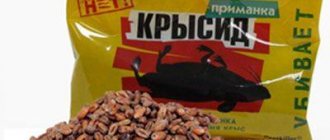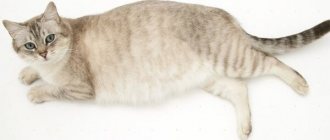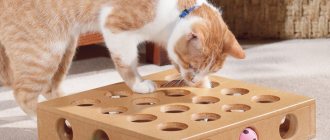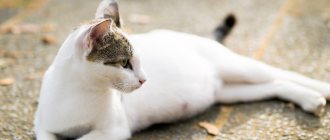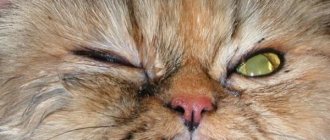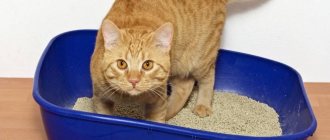Poisoning is a special process that disrupts the normal functioning of important organs as a result of the penetration of poisonous or toxic substances. A large number of different substances have been identified that can cause intoxication in a domestic cat.
It has been noted that poisoning in cats is diagnosed many times less frequently than intoxication in dogs. This is due to the fact that cats are more selective when swallowing various objects, especially those with a pronounced taste or smell.
But at the same time, cats are not known for chewing their food thoroughly. There are pets who do not even chew their food, swallowing it in large pieces. Even if an animal is unusually fastidious, if it is very hungry, it may not pay much attention to the suspicious taste of food.
Felinologists claim that cats, in the course of domestication and selection, began to gradually lose their natural function of distinguishing between poisonous and safe foods.
Poisoning in a cat when eating toxic substances occurs as a result of a highly developed hunting instinct. The most common cause of poisoning diagnosed in domestic cats is toxins ingested by poisoned mice and rats.
Zookoumarins are poisonous substances developed for baiting rodents; when ingested by a wild or domestic animal, they lead to disruption of blood clotting factors, causing internal hemorrhages.
The condition of an animal in case of zoocoumarin poisoning is interpreted as serious, and often causes death without the provision of necessary medical care.
Poisoning with rat poison
Is it very scary? Is it different from ordinary poisoning? Yes! and YES!
A cat can be poisoned by rat poison in two ways:
- By eating the poison itself (direct). Rodent baits have a pleasant taste, which makes them attractive not only to direct consumers, but also to dogs and cats.
- Eating a poisoned rodent (indirect). A poisoned rat or mouse, weakening, becomes easy prey for a cat. Modern means are very effective, so the portion of poison that enters the rodent’s body will be sufficient for a larger animal.
Rat killing products use rodenticides containing different active ingredients - coumarin, indandione, etc., therefore their effects on the body are different.
But most often cats suffer from anticoagulant rodenticides. We will consider them. Anticoagulants are chemical substances that prevent blood from stopping. Anticoagulant poisons contain coumarin: zoocoumarin, warfarin, flomucafen, coumatetralyl, bromodiolon, brodifacoum.
Forms of pancreatitis
Acute – characterized by acute girdling pain in the upper abdomen. Pain often appears after eating fatty foods or alcohol. Unpleasant sensations can be either barely noticeable or unbearable, radiating to the scapula or sternum. Nausea, vomiting, and stool disturbances are observed. Due to the obstructed flow of bile, the skin takes on a yellowish color.
Chronic - the main localization of pain is on the upper part of the abdominal wall with irradiation to the back, chest (left side), lower abdomen. Unpleasant sensations occur after eating heavy fatty foods, alcoholic drinks, and constant stress.
The development of chronic pancreatitis is characterized by nausea, loss of appetite, bloating, bowel dysfunction, and sometimes vomiting.
The chronic form of the pathology differs from the acute form by periods of remission and exacerbation. As the disease progresses, periods of exacerbation become more frequent; intestinal disorders, disturbances in normal digestion, and weight loss are possible.
Chronic pancreatitis often causes complications (stomach bleeding, cancer, cysts and abscesses, liver damage, diabetes mellitus, enterocolitis). That is why you need to take the disease seriously and, at the slightest suspicion of the development of inflammation, consult a doctor.
Symptoms:
Anticoagulant rodenticide poisoning may not appear immediately (signs usually develop on the first to fifth day), and the cat feels fine until its vitamin K resources run out.
The symptoms of rat poison poisoning are the same regardless of whether the cat ate the poisoned mouse or the bait.
These are: lethargy, refusal to eat, high temperature, internal and external bleeding: bloody vomiting, bloody diarrhea, hematomas, anemia of the mucous membranes, shortness of breath, tachycardia, neurological problems, convulsions.
In the case of rodenticides such as strychnine, bromethalin, zinc phosphide, symptoms may appear almost immediately after poisoning - lethargy, vomiting, anorexia, convulsions, hypertonicity of the extremities.
In case of poisoning with zoocoumarin, symptoms are observed for 4-7 days, with diphenacin - 2-4 weeks.
Where can a cat find a poisoned mouse?
A cat walking calmly down the street can catch a poisoned mouse. All of them are hunters by nature, and any of them will prefer the most ordinary mouse to even the best sausage. It is simply impossible to keep track of them.
If you place rodent poison, you should do this only in places where the cat cannot reach.
© shutterstock
Actions to take if poisoned by rat poison:
First , try to immediately induce vomiting in your pet. This will reduce the possibility of the poison being absorbed by the stomach and its further spread throughout the body. How to do it? It is advisable to use ipecac root syrup (emetic root), approximately 4 ml per average cat, in extreme cases, use 3% hydrogen peroxide, 1 teaspoon per 5 kg of weight. Sometimes it is possible to induce vomiting by giving the animal a large amount of boiled water and pressing on the root of its tongue.
But! This measure is effective if the poison was eaten recently. It makes no sense to induce vomiting in a cat after a few hours or when signs of poisoning appear, since the poison has already been absorbed by the gastrointestinal tract.
Secondly , give your pet an adsorbent (it doesn’t matter whether you managed to induce vomiting or not): activated carbon (1 tablet per 1 kg of weight, crushed, diluted in water and given to drink), enterosgel, enterosorb, etc.
Thirdly , apply an antidote! To restore the blood clotting mechanism, an injection of vitamin K1 is required.
Next, to maintain the animal’s body, infusion therapy (dropper) and symptomatic treatment are carried out, and local bleeding is stopped. In case of severe anemia, in those clinics where this is possible, blood transfusions are also given (since the synthesis of the clotting factor begins 6-12 hours after taking the antidote). It is advisable to place the animal in a veterinary hospital (at least for a day).
Now about vitamin K1 Vitamin K1 (phylloquinone, phytomenadione) is a fat-soluble vitamin necessary to restore blood clotting function.
Vitamin K1 has a coagulation effect; it increases blood clotting, strengthens the walls of blood vessels and reduces their bleeding.
There is veterinary vitamin K1 (Veta-K1, Veda-K1, Mephyton, Aqua-Mephyton), but, unfortunately, it can only be purchased abroad.
Therefore, the best option would be to use such human drugs as Vitamin K1, Eleven K, Fimediod, Phytonadion, Konakion, Konavit, Mefiton, Monodion, L-Phylloquinone. The funds are expensive, but necessary.
Unfortunately, Vitamin K1 is not available in all clinics and, especially, not in all home medicine cabinets. It is often replaced with vitamin K3 (Menadion, Vikasol) - a water-soluble synthetic analogue.
But! Vikasol is ineffective for coumarin poisoning; it is not able to replenish the necessary supply of vitamin K, and in high doses it can cause liver damage. Of course, if there is no way to get Vitamin K1, then out of desperation you can use Vicasol.
Reasons for the development of pancreatitis
The disease develops due to damage to pancreatic tissue. This happens for the following reasons:
- alcohol and tobacco abuse
- abdominal trauma, surgery
- uncontrolled and long-term use of medications: antibiotics, hormonal drugs, corticosteroids, some diuretics
- intoxication with food products, chemicals
- genetic predisposition
- improper diet with a predominance of spicy and fatty foods and long breaks between meals
Diagnosis and treatment
The diagnosis of rodenticide poisoning is made based on the owner's story, clinical symptoms of intoxication, blood tests for the presence of anticoagulants, urine tests and the body's response to treatment.
After emergency measures are taken and the animal is stabilized, he is prescribed maintenance therapy lasting several weeks, during which he will need to take Vitamin K1 tablets.
Discontinuation of treatment is based on a trial of drug withdrawal and control blood clotting tests.
The antidote for other types of rat poisons, as well as for arsenic, mercury and other thiol poisons, is Unithiol (human preparation). It is used, for example, if the poison contains arsenic in addition to zoocoumarin.
The prognosis for recovery depends on the type of poison and its amount, the time of diagnosis and the start of proper treatment. Under favorable circumstances it is approximately 83%.
Unfortunately, late onset of symptoms and untimely treatment at the clinic, and the lack of an antidote often lead to death.
Since vitamin K is metabolized in the liver, the prognosis for animals with disease in this organ is much worse.
How is laryngopharyngeal reflux treated at the Rassvet Clinic?
All patients with complaints of hoarseness, a feeling of a lump in the throat, difficulty swallowing, cough, a feeling of mucus in the laryngopharynx are examined by an otolaryngologist and a gastroenterologist.
An endoscopic examination of the nasal cavity, nasopharynx and larynx is performed to exclude other diseases that, in addition to LPR, can provoke these symptoms. The gastroenterologist also prescribes the entire necessary range of examinations, including excluding H. Pylori infection.
The key to successful therapy is joint management of the patient by an otolaryngologist, gastroenterologist, and in some cases a psychiatrist and psychotherapist.
Therapy
The first aid immediately after a cat swallows poison is the administration of drugs that induce vomiting, or the administration of large quantities of activated charcoal, followed by gastric lavage. Alas, in almost all cases when internal bleeding has already developed, it is necessary to transfuse the animal with blood or blood-substituting compounds, plasma. Considering that most domestic veterinary clinics do not have such capabilities, it is advisable not to let things get to this point.
A natural antidote to such poisons is vitamin K. Immediately after the start of treatment, it is administered by injection, when the animal’s condition stabilizes, they switch to prescribing tablets. At first, the vitamin is administered in loading doses, since under the influence of the poison most of it will still be destroyed in the body. Please note that it is best to use Vikasol for treatment , since multivitamin preparations contain too small amounts of it.
It should be remembered that there are different options for anticoagulant compounds, each of which remains in the animal’s body for a different time. This can make it very difficult to determine when it is time to end treatment. As a rule, they do this: stop prescribing the drug, and then (two days later) take a blood test. Platelet levels are checked. If the poison remains in the animal’s body, their level will be noticeably reduced, and therefore therapy is continued. If all indicators are normal, the medication can be stopped completely.
Symptoms
As we have already said, the standard dose of poison is too small for signs of poisoning to appear immediately: this takes at least three to five days. However, the possibility of a cat repeatedly eating poisoned mice cannot be ruled out. In this case, the poison accumulates (even if the doses were very small). If a cat eats a richer rodent, signs of poisoning will likely appear very quickly.
General symptoms of rat poisoning in cats in this case directly indicate problems with the blood clotting process and the presence of internal bleeding. This includes lethargy and an apathetic state, the animal is indifferent to everything that happens to it, tries to hide in the farthest corner, there is a cough and difficulty breathing (due to pulmonary hemorrhage or hemothorax). Also, in severe cases, the abdomen becomes noticeably swollen, which directly indicates generalized internal bleeding. If you do not immediately help the cat at this moment, he will die.
Basic information
The most common poisons today are those whose operating principle is based on a disorder of blood clotting, causing a mouse that eats a poisoned bait to die from internal bleeding. The most commonly used bases are: Brodifacoum, Difacion, Warfarin and Bromadiolone. These are very effective anticoagulants. Please note: in most cases, rat poisons containing these substances are green in color. This is necessary for pet owners, since cats themselves do not see shades of green.
When this poison enters a cat's body, it destroys vitamin K and blocks blood clotting mechanisms. It should be noted that manufacturers of deratization products try to select the dose of poison so that a cat or dog that accidentally eats it does not immediately bleed to death, so that the owner has enough time to call a veterinarian and administer an antidote. However, if your pet gets hold of the package of poison, this rule will not work.
Important! If your cat has eaten mouse poison, do not let him drink it under any circumstances! If the dose was large, it will immediately develop internal bleeding, from which the animal will die.
By the way, how are cats poisoned by poisons intended to kill rats? Judging by research by veterinarians and pest control companies, more than 90% of cases occur when cats eat poisoned rodents. As you might guess, the poison does not have time to be eliminated from the body of a mouse or rat, which is why the cat that eats it also receives a loading dose of poison. Much less often, animals eat the rodent killer directly, or pick up poisoned bait accidentally or intentionally left on the street.
Precautionary measures
It just so happens that cats are predators, and eating rodents is a natural behavior for them. Accordingly, they will always be at risk; it is very difficult to prevent cases of poisoning. Perhaps the most protected are cats living in city apartments, but even in this case it is possible that poisoned rodents may enter the house (during mass deratization).
So here everything depends on the vigilance and attentiveness of the animal’s owners. If you hear that your area will be treated for rats and mice (and by law, the sanitary and epidemiological station is required to warn about this), do not let your cat go outside. If you notice something strange in your pet's behavior, immediately take him to the veterinarian: it is possible that he has already eaten a poisoned rodent. Always have a supply of activated carbon at home, with which you can provide first aid to your cat in case of poisoning.
Important! Be sure to try to find packaging or samples of the poison. This will help in prescribing adequate therapy.
